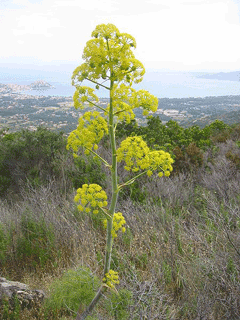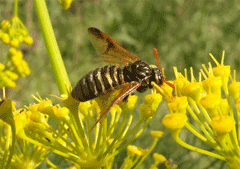 |
|
http://commons.wikimedia.org/wiki/User:Tigerente |
 |
| http://commons.wikimedia.org/wiki/User:Etrusko25 |
Translate this page:
Summary
Physical Characteristics

 Ferula communis is a PERENNIAL growing to 2.5 m (8ft) by 1 m (3ft 3in).
Ferula communis is a PERENNIAL growing to 2.5 m (8ft) by 1 m (3ft 3in).
See above for USDA hardiness. It is hardy to UK zone 8 and is not frost tender. It is in flower in June. The species is hermaphrodite (has both male and female organs) and is pollinated by Flies. The plant is self-fertile.
Suitable for: light (sandy), medium (loamy) and heavy (clay) soils and prefers well-drained soil. Suitable pH: mildly acid, neutral and basic (mildly alkaline) soils. It cannot grow in the shade. It prefers dry or moist soil and can tolerate drought.
UK Hardiness Map
US Hardiness Map
Synonyms
F. brevifolia. F. linkii.
Plant Habitats
Cultivated Beds; East Wall. In. South Wall. In. West Wall. In.
Edible Uses
Edible Parts: Leaves
Edible Uses: Gum
Leaves[183]. No further details are given.
References More on Edible Uses
Medicinal Uses
Plants For A Future can not take any responsibility for any adverse effects from the use of plants. Always seek advice from a professional before using a plant medicinally.
Miscellany
One report says that the root yields a gum with medicinal properties but no details are given[1].
References More on Medicinal Uses
The Bookshop: Edible Plant Books
Our Latest books on Perennial Plants For Food Forests and Permaculture Gardens in paperback or digital formats.

Edible Tropical Plants
Food Forest Plants for Hotter Conditions: 250+ Plants For Tropical Food Forests & Permaculture Gardens.
More

Edible Temperate Plants
Plants for Your Food Forest: 500 Plants for Temperate Food Forests & Permaculture Gardens.
More

More Books
PFAF have eight books available in paperback and digital formats. Browse the shop for more information.
Shop Now
Other Uses
Furniture Gum Miscellany Tinder
A gum 'Gum Ammoniac' is obtained by notching the root[46, 61, 64, 100]. It is used as an incense[4], it also has medicinal value[1]. The stems are used in furniture making[89]. The dried pith is used as a tinder, it burns very slowly inside the stem and can thus be carried from one place to another[89, 100, 148].
Special Uses
Scented Plants
References More on Other Uses
Cultivation details
Succeeds in most soils[1] including dry ones according to one report[190] whilst others say that it requires a deep moist fertile soil in a sunny position[111, 200]. Established plants are drought resistant[190]. This species is hardy to about -10°c, possibly lower if the rootstock is mulched in the winter[187]. A very ornamental plant[1], though the flowers have a most unpleasant rancid smell[245]. Plants are often monoecious[187]. Plants are intolerant of root disturbance due to their long taproot[200]. They should be planted into their final positions as soon as possible. The sub-species brevifolia is the form used for its gum[1, 46, 61, 100].
References Carbon Farming Information and Carbon Sequestration Information
Temperature Converter
Type a value in the Celsius field to convert the value to Fahrenheit:
Fahrenheit:
The PFAF Bookshop
Plants For A Future have a number of books available in paperback and digital form. Book titles include Edible Plants, Edible Perennials, Edible Trees,Edible Shrubs, Woodland Gardening, and Temperate Food Forest Plants. Our new book is Food Forest Plants For Hotter Conditions (Tropical and Sub-Tropical).
Shop Now
Plant Propagation
Seed - best sown as soon as the seed is ripe in a greenhouse in autumn[1]. Otherwise sow in April in a greenhouse. Prick out the seedlings into individual pots as soon as they are large enough to handle. Plant them out into their permanent positions whilst still small because the plants dislike root disturbance[1]. Give the plants a protective mulch for at least their first winter outdoors. Division in autumn. This may be inadvisable due to the plants dislike of root disturbance.
Other Names
If available other names are mentioned here
Native Range
TEMPERATE ASIA: Yemen, Cyprus, Egypt (Sinai), Israel, Jordan, Syria, Turkey EUROPE: Albania, Greece (incl. Crete), Croatia, Italy (incl. Sardinia, Sicily), Montenegro, Spain (incl. Baleares), France (incl. Corsica), Portugal AFRICA: Algeria, Libya (north), Morocco, Tunisia
Weed Potential
Right plant wrong place. We are currently updating this section.
Please note that a plant may be invasive in one area but may not in your area so it's worth checking.
Conservation Status
IUCN Red List of Threatened Plants Status :

Growth: S = slow M = medium F = fast. Soil: L = light (sandy) M = medium H = heavy (clay). pH: A = acid N = neutral B = basic (alkaline). Shade: F = full shade S = semi-shade N = no shade. Moisture: D = dry M = Moist We = wet Wa = water.
Now available:
Food Forest Plants for Mediterranean Conditions
350+ Perennial Plants For Mediterranean and Drier Food Forests and Permaculture Gardens.
[Paperback and eBook]
This is the third in Plants For A Future's series of plant guides for food forests tailored to
specific climate zones. Following volumes on temperate and tropical ecosystems, this book focuses
on species suited to Mediterranean conditions—regions with hot, dry summers and cool, wet winters,
often facing the added challenge of climate change.
Read More
Expert comment
Author
L.
Botanical References
89200
Links / References
For a list of references used on this page please go here
Readers comment